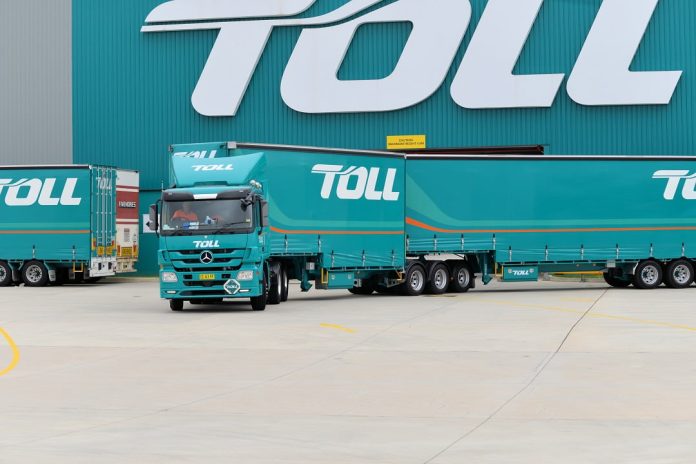Toll Global Express’(TGX) vast new Bungaribee facility lies at the heart of one of the most complex and sweetly conceived enterprise security solutions we’ve seen. The system combines video surveillance, access control, intrusion detection, vehicle and package tracking, fire, lighting, help points, and layers of real time event monitoring, locally and on a national scale.
FREIGHT companies face considerable security challenges that extend beyond the confines of physical sites. They must secure a customer’s freight from pickup to drop-off, across thousands of kilometres, through multiple facilities, and many vehicles and pairs of hands. It’s this broad imperative that governs the nature of the security application at Toll.
Security here is holistic – not just in the sense that it covers Toll’s huge new facility at Bungaribee, and not just in the sense it covers every one of Toll’s 67 facilities nationally. Security is intrinsic to the fundamental operation of Toll’s entire business. And while the electronic security system at Bungaribee lies at the heart of Toll’s national security operation, at the heart of that security operation is a powerful idea – video verification.
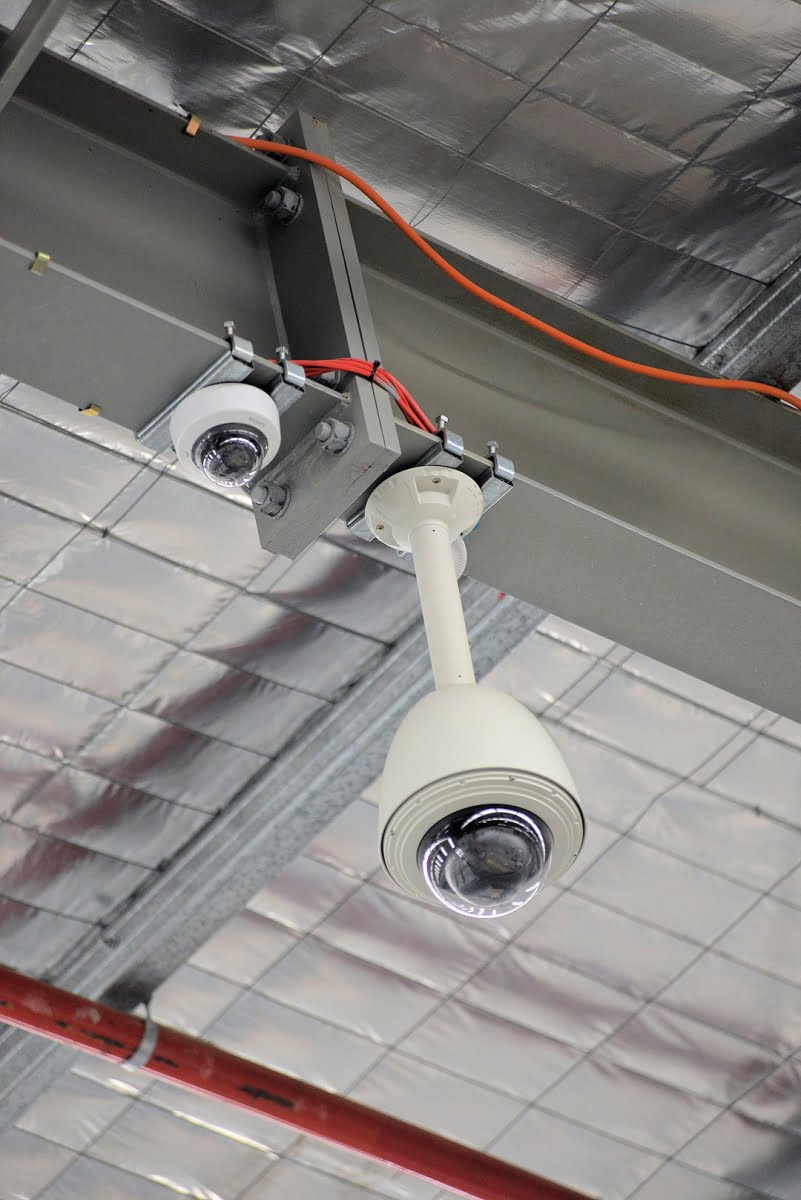
In 2002, Toll’s divisional security manager Rod Grimshaw and his team conceived a security strategy they’ve been polishing and re-applying ever since. They decided to integrate video surveillance with access control and intrusion alarms and to undertake inhouse monitoring of alarm events and associated video footage remotely across all Toll Global Express sites.
“We started small with this idea and as we grew, the idea grew with us,” Grimshaw explains. “The model we created in 2002 has underpinned every one of the 67 sites we’ve undertaken since, in terms of standards and system design. We’ve enhanced that original design as technology has changed but the underlying model remains the same.
“This decision has impacted on the nature of our security solution. Because our operators are dealing with thousands of cameras nationally, we’ve had to source and develop solutions that are automated, giving us alerts with video – that’s been the driving force.”
Toll’s security solution at the enterprise level is vast. The core is Software House C-Cure, with controllers installed in every site and monitored locally in some cases, as well as being monitored by the Grade 1A standard control room now completed at Bungaribee. This system includes 116 C-Cure iStar door controllers and 22 C-Cure Advanced Processing door controllers.
Incorporated into the C-Cure system across 67 sites are 7549 inputs, 2340 outputs, 1293 doors/gates, 14,350 programmed events, and a database of 23,000 cardholders users with 1140 levels of clearance. Supporting this are remote monitoring stations, comprised of a combination of the national monitoring centre and 26 authorised security manager workstations at key sites.
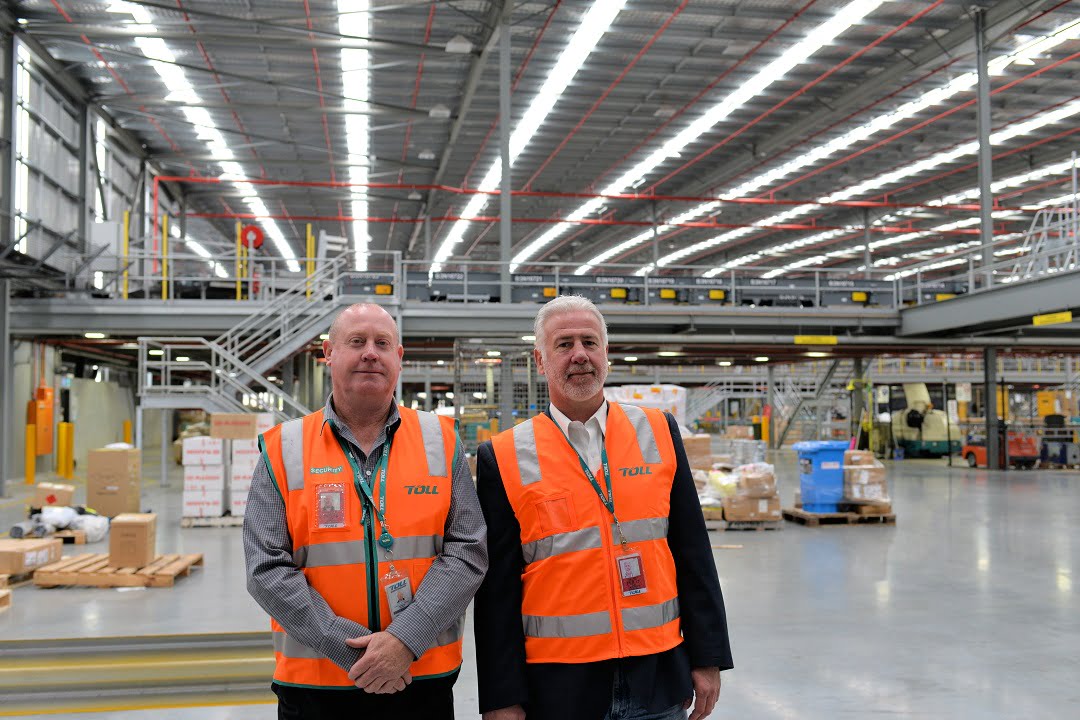
Paul Noring (left) and Rod Grimshaw
“We chose Software House’ C-Cure solution for Bungaribee – we needed to know how quickly the system we chose could expand in an enterprise framework across a large number of sites given the number of alarm and access control points required,” Grimshaw explains. “Our experience across our other sites over many years showed C-Cure was ideal for us. Software House has been really good at working with us on enhancements on the access control and alarm side and we wanted to retain that backend development.”
When it comes to video surveillance, Toll has 56 Intellex NVRs and 58 Exacqvision NVRs supporting 2320 cameras. Tyco Security Products’ Victor Software Management System manages cameras and facilitates integration with C-Cure. While these numbers are significant, they don’t include the nearly-completed Tullamarine facility, which incorporates another 570 cameras and 110 access control doors/gates along with associated inputs and outputs. And while many metropolitan sites have security staff 24×7, other sites employ thermal cameras and other intrusion detection devices to create a highly secure space allowing rapid response without false alarms.
While I’m sitting at the board room table trying to get my head around Toll’s national security solution, Grimshaw and Toll’s Bungaribee security manager Paul Noring start explaining that the integrated nature of Toll’s security operation reaches its pinnacle on this site. Here, the security operation and the site’s freight sortation system have been integrated to create a security and safety solution of great power.
The Bungaribee site
It goes without saying that Toll’s facility at Bungaribee is big. Earlier, it took me longer than expected to find the entrance and now I’m inside the facility and peeking out the windows of the centrally located boardroom, it seems larger still. Complicating matters are the site’s multiple wings, as well as the towering skeleton of the sortation system, which obscures long range views.
Opened in November 2014, Bungaribee has 187,000sqm of concrete hardstand – that’s around 18 hectares. Buildings take up 57,000sqm, while the multi-storey main office area is another 3390sqm. The perimeter, including docks, stretches 6km, while the belt sortation system, which is covered by unbroken CCTV views from multiple angles, is 3.8km long. Onsite facilities include Toll’s National Security Monitoring Centre, a security gatehouse for returning ‘pick and delivery’ vehicles, a fully equipped and functionally fleet workshop and automated truck wash, rest and sleeping facilities incorporating full kitchen functionality to cater for 40 line haul drivers. There’s also a separate building for customers picking up and delivering freight at the depot to ensure they are not put at risk by heavy vehicles. And at any one moment there are 400 staff and 300 trucks on the site.
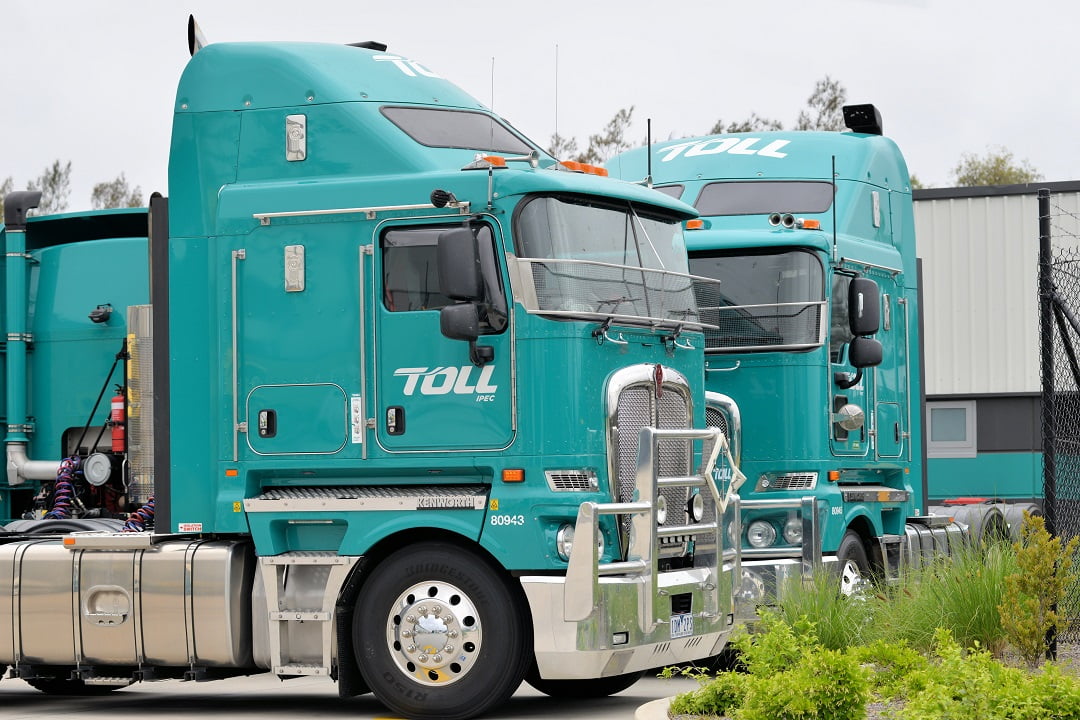
According to Grimshaw, the governing principles of the electronic security solution at Toll relate to defence in depth.
“We were looking for a practical and economic solution to achieve the 4 ‘D’ outcomes to mitigate both external and internal compromise,” Grimshaw explains. “These outcomes include Deter, Delay, Detect and Detain.
“While the electronic security system doesn’t itself provide a delaying measure, it does serve to provide the remaining measures: deter, detect, and detain. When it comes to CCTV, it’s an essential tool we’ve successfully utilised many times over to locate, visually track, and subsequently direct police to the actual location of where offenders had concealed themselves within our sites.
“In terms of deterrent and detection, we operate an internal 24×7 security monitoring centre and employ in-house licensed security officers who continually remotely monitor and patrol Toll TGX sites nationally using our CCTV systems,” Grimshaw says.
“These officers frequently identify suspicious persons loitering around our sites and/or vehicles and they are able to connect to onsite PA systems and/or activate on site audible alarm (screechers) to warn potential offenders away, often prior to an attempted breach.
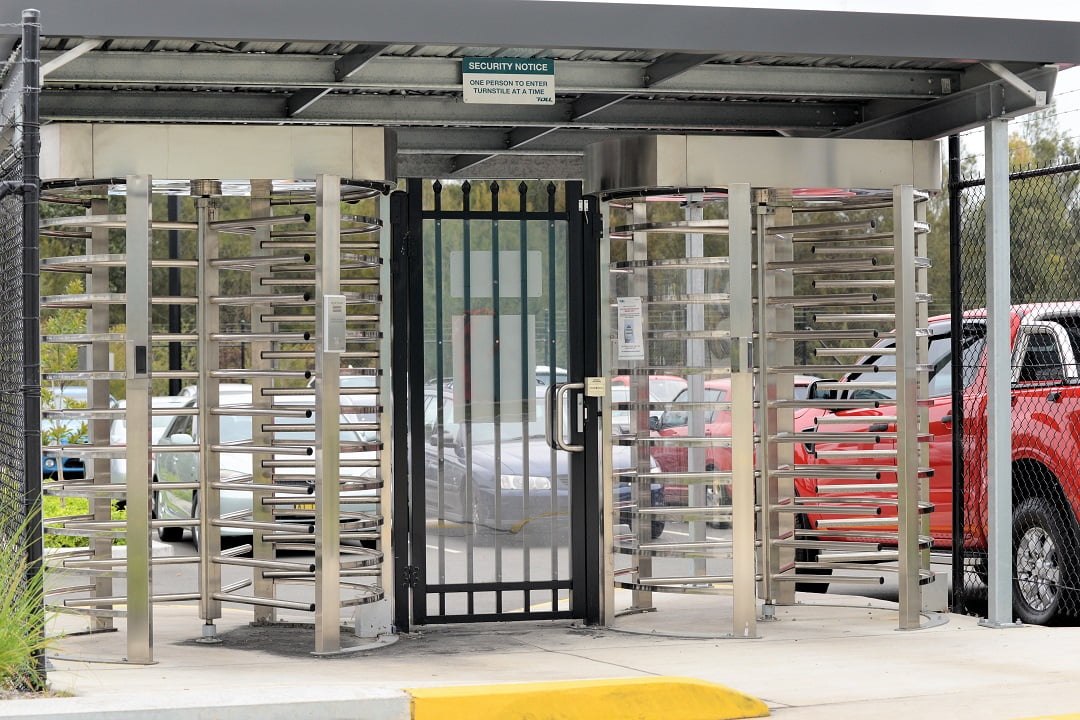
“Our CCTV systems are also fully integrated with our electronic access control and alarm systems, so when an attempted breach is detected by the intrusion sensors, our monitoring centre officers are automatically provided with live on screen CCTV footage of the specific area of the breach and they can quickly initiate appropriate response by the local authorities.
“On this site our CCTV system has been developed to integrate with the freight sortation system, a monster belt maze that carries freight across a distance of more than 4 kilometres throughout the 57,000 sqm shed,” Grimshaw says. “This integration provides us with the ability to identify each individual item of freight by its address barcode and from each scanning point, video track the freight as it is processed and sorted.”
According to Grimshaw, while CCTV systems have historically been utilised solely as security and loss prevention tools, Toll also uses CCTV to provide safety enhancements for its people.
“Having the capability to use the systems to identify potential safety issues across such a large area from a central location is an example of the CI (continuous improvement) provided by the system,” Grimshaw explains. “The ability to respond from a safe distance is a key CI capability we now have. A recent example was hail storms some months back that caused significant damage to many warehouse and distribution sites in the area. We were able to check roofs externally, as well as searching for water damage to our electrical system internally to ensure staff safety after the storm.”
Bungaribee security solution
Bungaribee employs C-Cure for intrusion and access control, Exaqvision NVRs for local storage and a Victor head end integrating alarm and access events with CCTV footage. Coverage is comprehensive. There are more than 470 Sony Generation 6 cameras of 10 different types, storage is greater than 500 Terabytes, and there are multiple monitoring locations both onsite and at remote locations.
Network topology at Bungaribee is a star configuration, with typical comms paths running from camera, to layer 2 switch infrastructure in the nearest of the site’s 14 comms room and even more comms cabinets. From layer 2 switch, video streams are passed to a core switch running layer 3 routing.
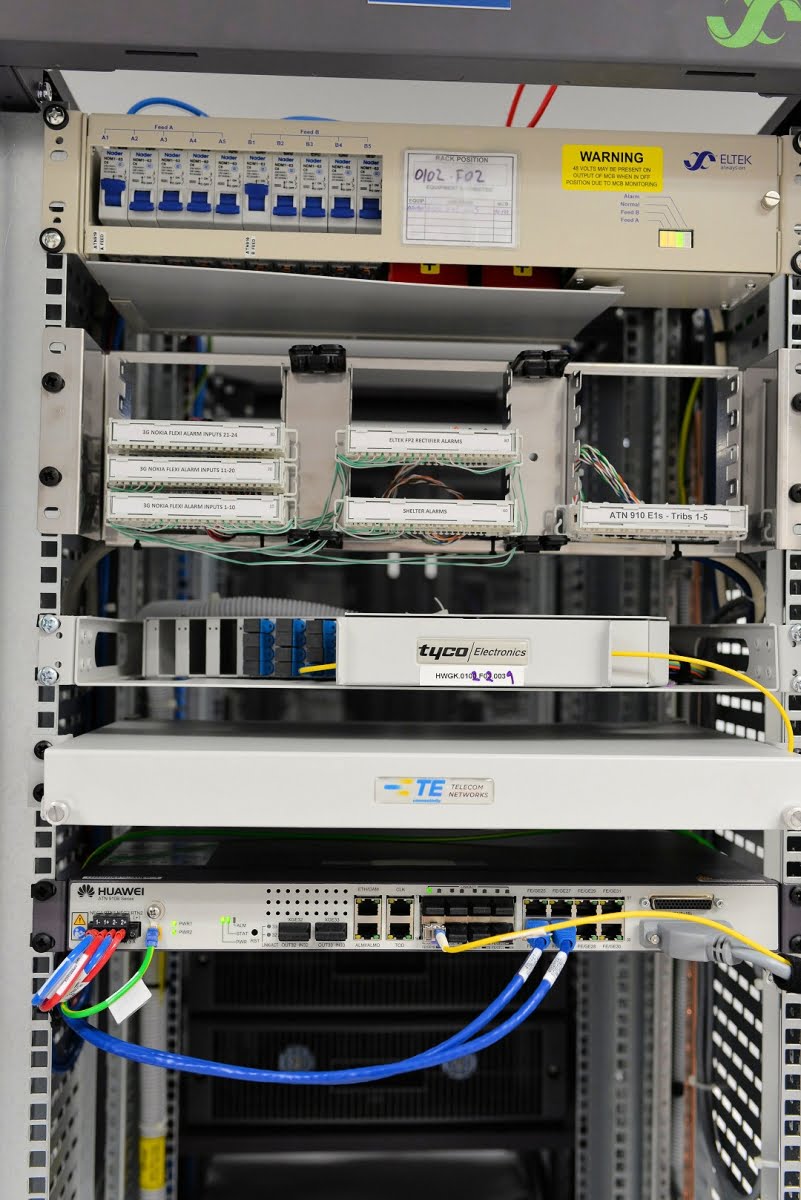
“In effect, data rates around the depot on the LAN run in excess of 20 gigabits per second,” explains Grimshaw. “And everything is secured behind a separate virtual LAN dedicated to the security infrastructure. In some areas with many cameras we have a dedicated switch for the CCTV system but we use a VLAN in areas with fewer cameras to provide cost synergies with other IT infrastructure. We need a minimum of 60 days footage from our cameras – that’s why our storage requirements are so large.”
In terms of the CCTV system, NVRs are installed locally and operators access them remotely to view real time footage, with critical event footage stored at the National Security Monitoring Centre. When it comes to the access control system, there’s a server in Toll’s main comms room at Bungaribee, a server at Toll’s primary IT site in Melbourne with redundant paths and several network carriers, along with network clients that can be monitored locally by operators or authorised managers.
“What’s the head end handling the CCTV?” I ask.
“Back in the old days we used Intellex (Sensormatic) DVRs which given video compression and bandwidth issues in that era, were wonderful for live video streaming,” Grimshaw explains. “We then went to a hybrid solution and now we are fully IP – we use ExacqVision, which includes behavioural analytics. This was the first site to which we applied vehicle number plate recognition.
“We are fundamentally looking at the same analytics as those being used in the retail environment, but customised to our industry requirements. For example, rather than observing cash register transactions, we can use the system to video track freight and monitor traffic flow. In the future we may be able to see if too few people are trying to process too much freight. We will also use analytics for speed alerts around the site, which is another CI safety component.”
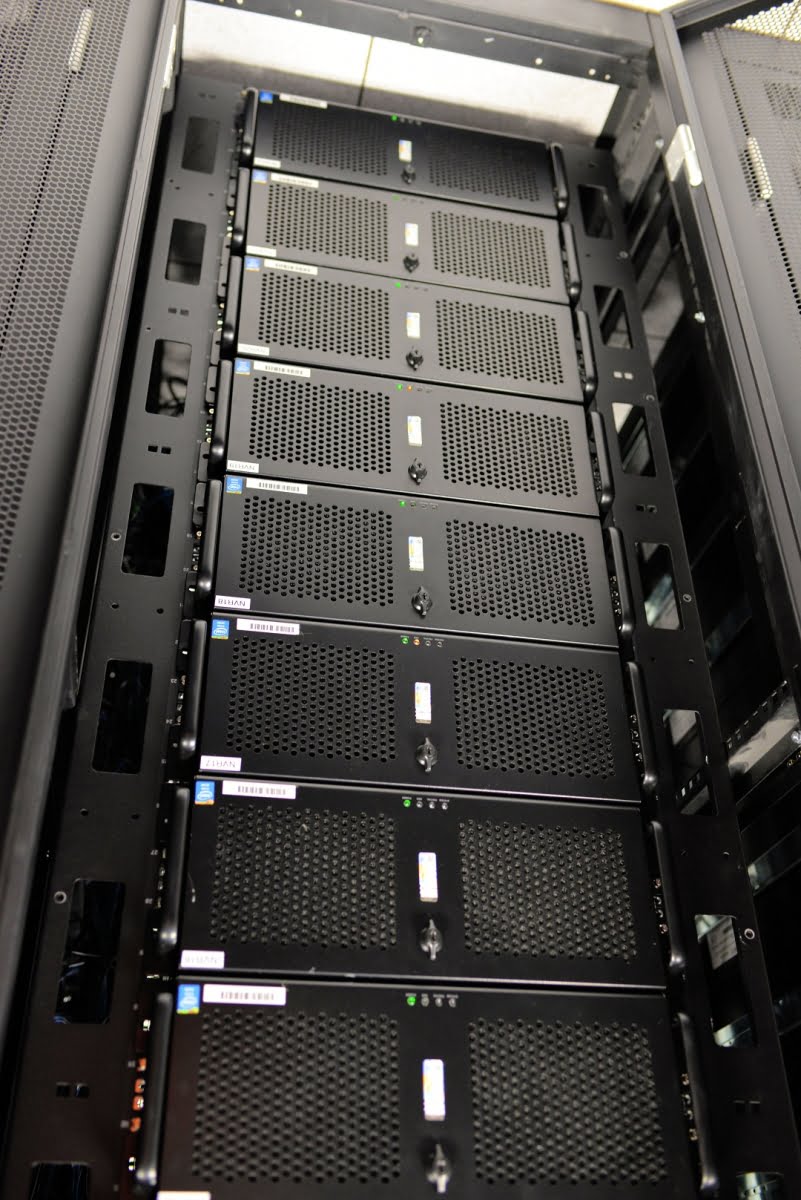
“You obviously have different cameras that are used internally and externally?” I ask.
“Traditionally, we’ve used lots of PTZ domes to allow the control centre to patrol sites but we’ve been moving towards more fixed cameras as camera resolution now allows more effective digital zooming,” Grimshaw tells me. “Domes are more for internal operations, as well as for specific targeting work externally. Domes are also great for remote patrols in regional depots.
“Most our cameras are 1080p and recording frame rates vary depending on camera application. The belt sortation system runs at 2.7 metres per second – we run 15-18 frames per second in cameras monitoring the belt. External cameras run at a rate of 5-8 frames per second, some internal cameras are set around 10, our LPR cameras are fairly high to capture moving vehicles, while our internal cameras in quiet areas are on 5 frames per second.”
The security installation here incorporates more than 50km of conduits and as I listen, the size of the system and its multifarious links to remote sites begin to challenge my comprehension. Any application this large and complex is going to be a long time in the planning.
“The time from submitting a basic plan, costing, Capex, going to tender, exchanging contracts and doing the build was probably 2-and-a-half years,” Grimshaw says.
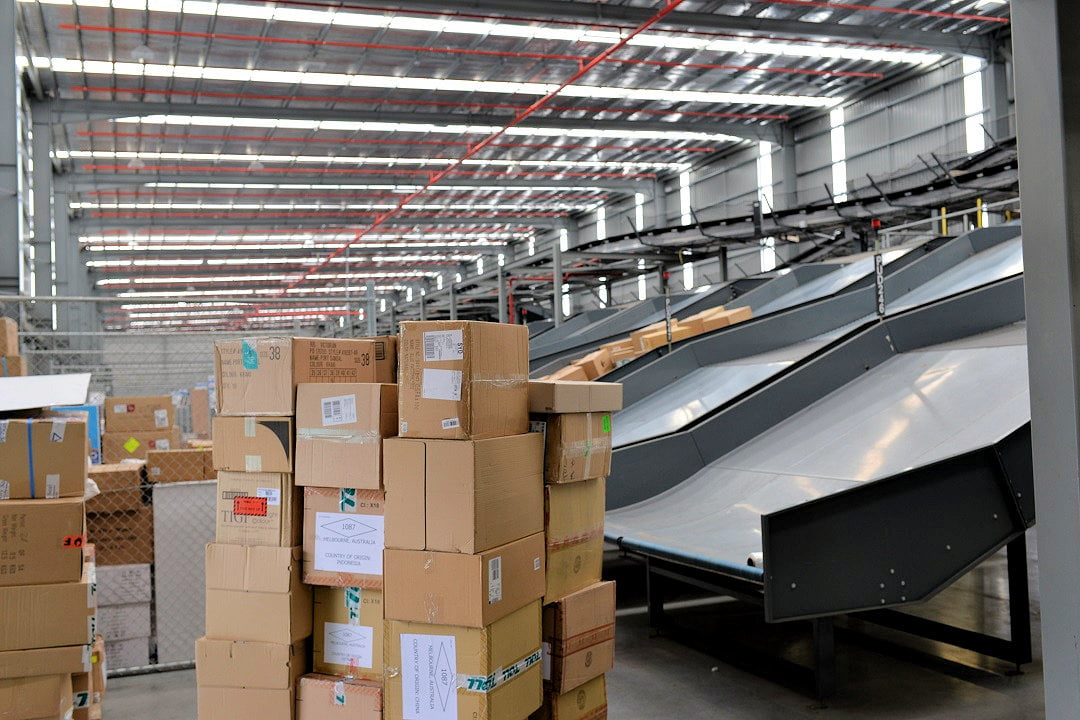
Something that’s necessary but not easy to get across to readers is the hands-on nature of Toll’s security operation and talking to Grimshaw, you get a strong sense of the source of that technical and operational pragmatism. Supporting management and operations staff, Toll has an inhouse team of electronic security technicians, along with IT security technicians.
“Our inhouse technicians played a vital role, given this is an IP-based system and of course, our CCTV cameras are all integrated with our C-Cure alarm/access control system,” Grimshaw says. “Every alarm and access point nationally is monitored at our Grade 1A standard control room with associated video footage and as you can imagine, a lot of programming went into that back-end.”
System installation
While Toll has inhouse electronic security technicians that were involved in the installation process, an application this large called for outside help.
“Our installation model depends on the site of the site,” Grimshaw explains. “For smaller sites (6000-10,000sqm), we design the systems taking into account input from stakeholders or any quirks of the site. We’ll do a design brief, cable scheduling, set out which equipment we want, with flexibility for things like alarm sensors, but specifying cameras, backend, storage requirements. With smaller sites, we’ll buy the equipment ourselves and give the install contract to an integrator.
“But with very large sites like this where we don’t want issues of demarcation, we’ll do the design and the rest will go through a tender process to a third party integrator. Having our own people handle design, project management, programming and commissioning, saves money we can use for equipment.
“In the past we’ve tried to have one supplier for data and security but here we put an IT spec out to our IT department and said this is where our system is going, we need switch rooms in these locations, does this suit. So our IT department did all the IT infrastructure right up to the patch point and the electronic security installers went patch-point to camera.”
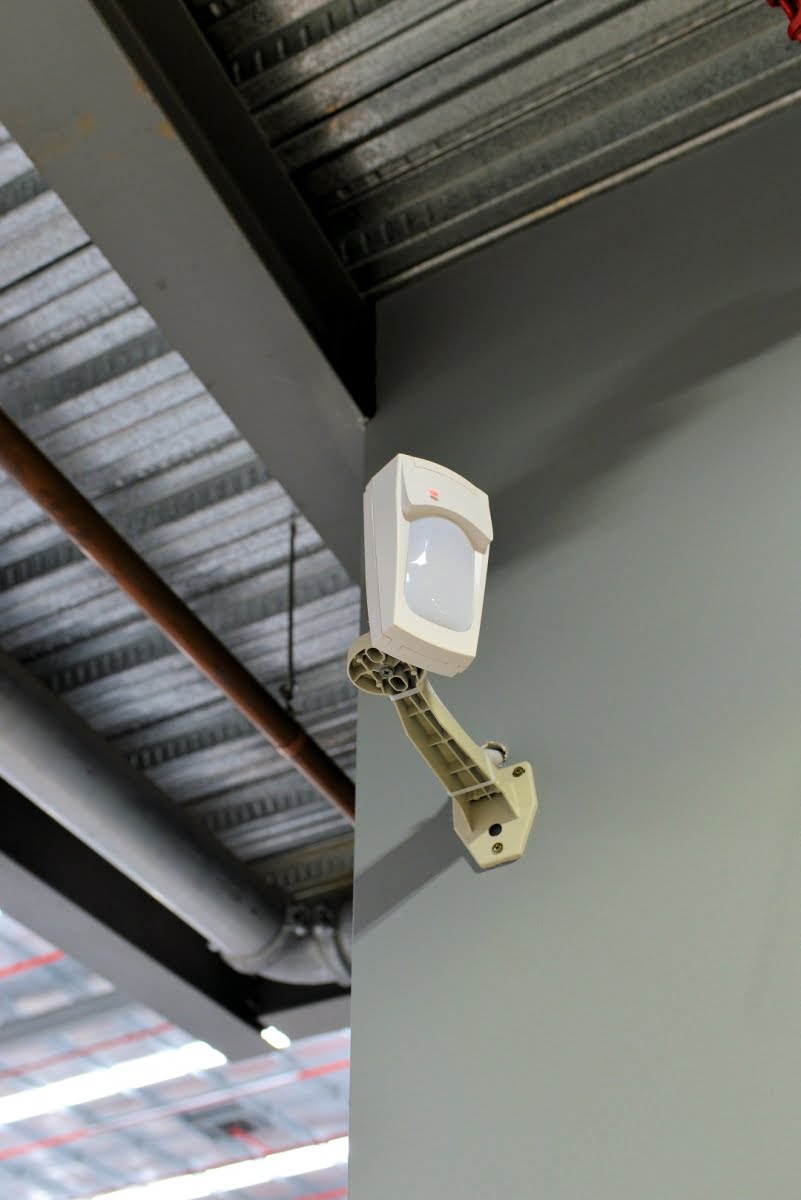
According to Grimshaw, while Toll has specific equipment needs, those needs are uniform, so once part of the installation is done, the rest is very much the same, making the task easier.
“Our IT security manager and our national electronic security systems manager worked closely together following the hard install at Bungaribee to ensure full integration into all the other sites and systems we link into,” Grimshaw explains. “As well as the sortation system controls, that included emergency call points, alarm and access control, fire alarms, IT network alarms, GPS tracking systems, number plate recognition and vehicle fleet management systems and lighting.”
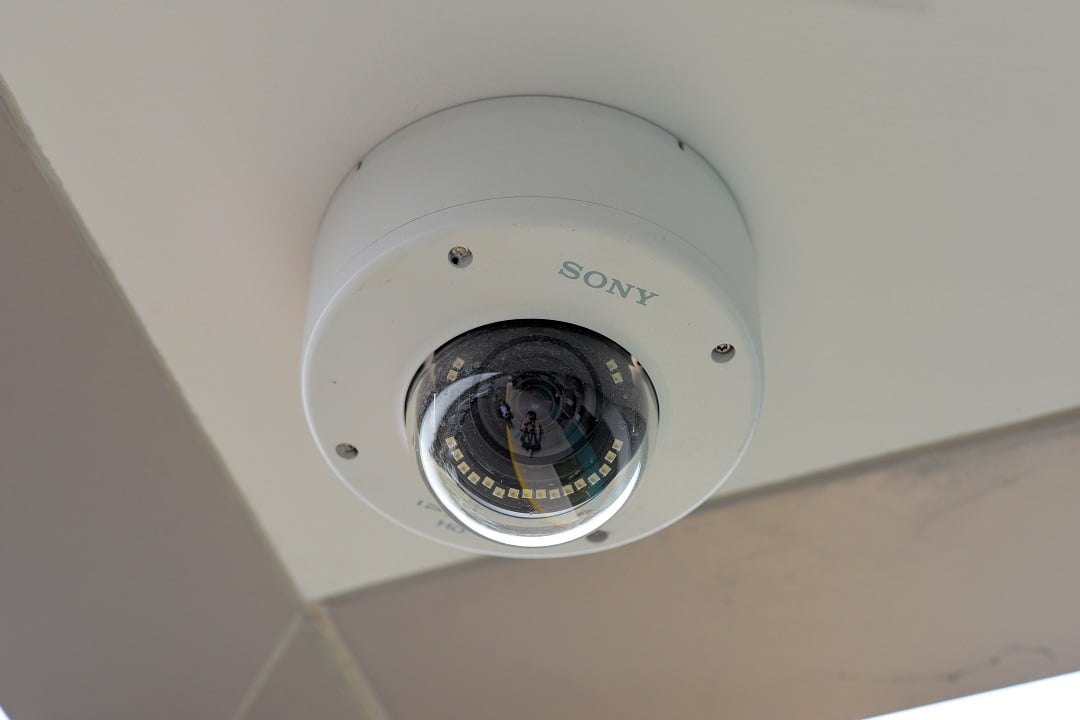
“When it came to camera lenses on a site this varied, what did you choose?” I ask.
“Our lens choices were all function-based,” Grimshaw says. “In terms of the cameras, most are 1.3MP, some are 2MP and some are 5MP – the cameras over the main gates. Lower resolution mini domes are ideal for the smaller areas of reception areas and comms rooms.
“One of the biggest issues we faced was selecting the right kind of camera – we’ve used a number of different cameras over the past 14 years and in the last 2 years we’ve partnered with Sony. We find Sony cameras fantastic but the issue was to find the right Sony cameras for our broad range of applications.
“We sat down with Sony’s Steve Charles and Sony technicians and got input as to which cameras they thought were best for our application – and they kept us up to speed on the products that were about to be released during the process of the entire project, which was great. Sony also came up with a very economical price and accommodated the many variables of our long project time,” Grimshaw says. “We’ve gone with Sony in many of our depots now, including at Tullamarine in Melbourne, which will have 580 cameras.
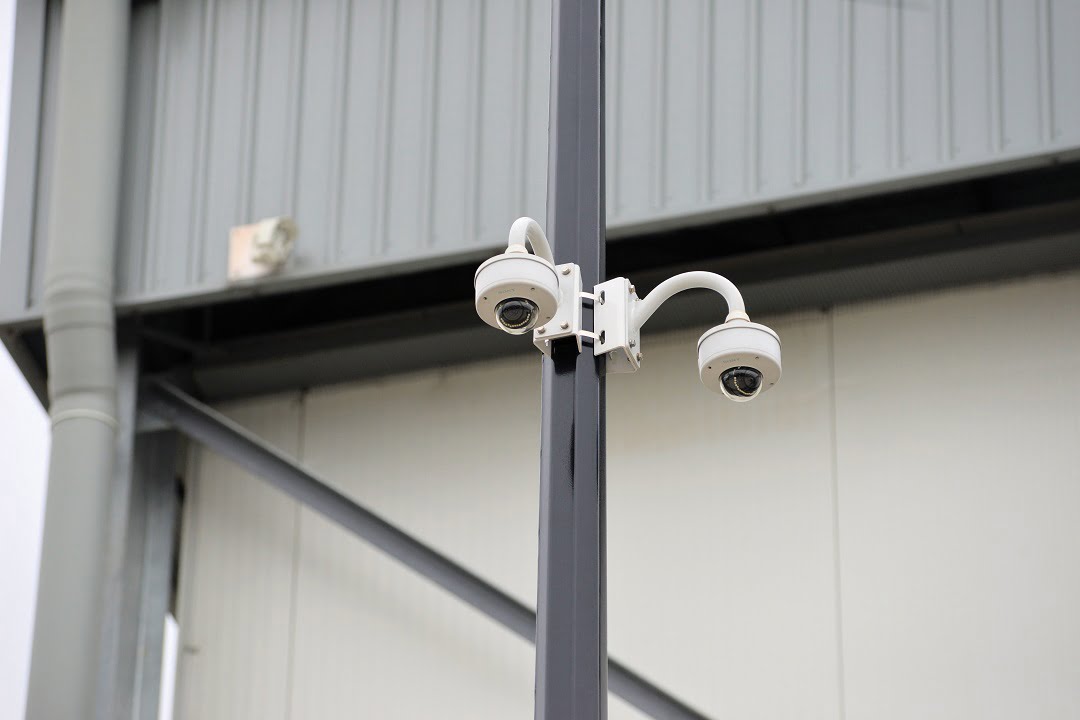
“Things we like about the Sony cameras include low light and WDR performance and remote autofocus, which is especially important given we have so many cameras installed high up. That feature probably saved us a week’s work or more. Remote autofocus alleviated the need to go through slow process of focussing each individual camera at the fit-off location. At this site, cameras are installed in very difficult areas, sometimes right above the sortation system, and to access them would require specialised lifting equipment.
“Our own security installers found the Sony products were consistent and easy to configure and the image quality is exceptional and has aided the security department immensely,” Grimshaw says.
Challenges of the application
This is a mighty application, I point out to the boys. Just combining the database, the access points, the alarm inputs, the CCTV cameras, the barcode integration text stream on the sortation system – the local and remote infrastructure – wow. And that doesn’t taken into account designing the system, setting up camera views, integrating the remote sites, the sub systems.
“This solution is massive and it has taken a long time to build,” says Grimshaw. “It was especially challenging in terms of programming and commissioning – obviously the more programming and commissioning you have to do, the easier and more intuitive it is for operators who must navigate large numbers of cameras. And the programming of all system components needed to meet our Toll programming standards.”
Alarm events are all on camera presets?
“Yes, so during installation it’s all about targeting and a lot of programming,” Grimshaw says. “Because we have been doing this for Toll TGX for 14 years we do have a template in terms of which doors are programmed to fail safe and which are fail secure, what alarm event triggers what response action and so on – so it’s a set platform of programming. But the process is highly demanding.
“Other challenges relate to accessing LAN and WAN infrastructure, as well as the sheer size of the site, the complexities of working around builders, sortation system engineers, IT installers – all this made having a committed works schedule nearly impossible. All we could do was ensure we had a substantial level of flexibility from our project supplier.”

Not surprisingly, the physical presence of the sortation system was a huge challenge for the team.
“When it came to the sortation system, blind spots are not visible on a 2D site plan,” explains Grimshaw. “To assist us, sortation system engineers came up with a 3D computer graphics program we could use for design and planning. We could see the height and multiple layers of the sortation system and take into account obstructions – that’s how we organised camera placements and selected our fields of view.”
But it was not only about designing the system to see around the sortation system. Video tracking of items on the sortation system was another huge challenge.
“The sheer number of cameras to maintain continuity imposed demands and we also needed our suppliers to work with sortation system engineers organically,” Grimshaw says. “Progress on construction of the sortation system was based on what components were available – a totally separate schedule was required in relation to the sortation system.”
Obviously, a primary challenge of any IP solution is having the LAN and WAN available at appropriate times so the team could properly tweak the cameras and systems before going live. Furthermore, the security system, including CCTV, had to be running before the facility could operate. Along with these challenges and deadlines, there were also smaller issues the team faced that face techs in any installation.
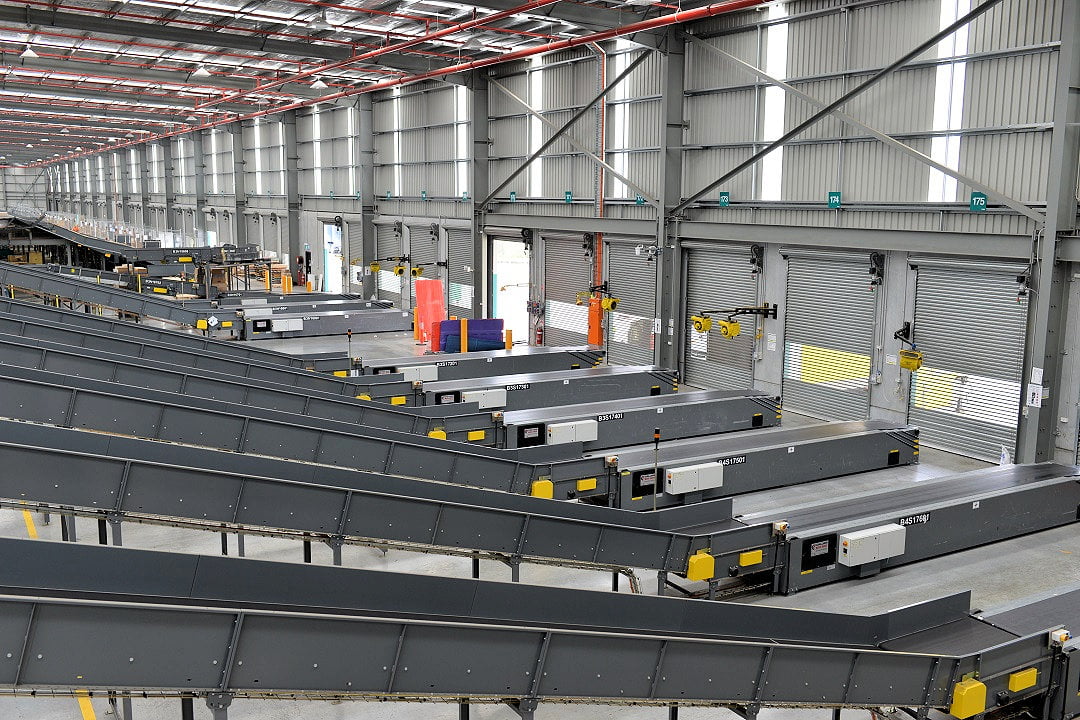
“Because of the enormity of the site, associating a particular camera license to a particular NVR – that was huge,” Grimshaw says. “And making sure we had the flexibility to move a license from one NVR to another and working out the necessary bandwidth requirements was also challenging.”
Integration with the sortation system
Fundamental to the CCTV system here at Bungaribee is its integration with the 3.8km sortation system dominating the internal spaces of the facility.
“A key aspect of this system is that we have integrated this barcode scanning system into our video surveillance system and from this we can video the freight and identify every single carton from the barcode, even if 1000 items are identical, and we can call up video footage of each individual item as it is processed by the system,” Grimshaw explains.
“We do this at every depot so if we need to search for an item or if we have issues where customers have not addressed items properly – we can use the system to identify when items go onto the wrong trucks.”
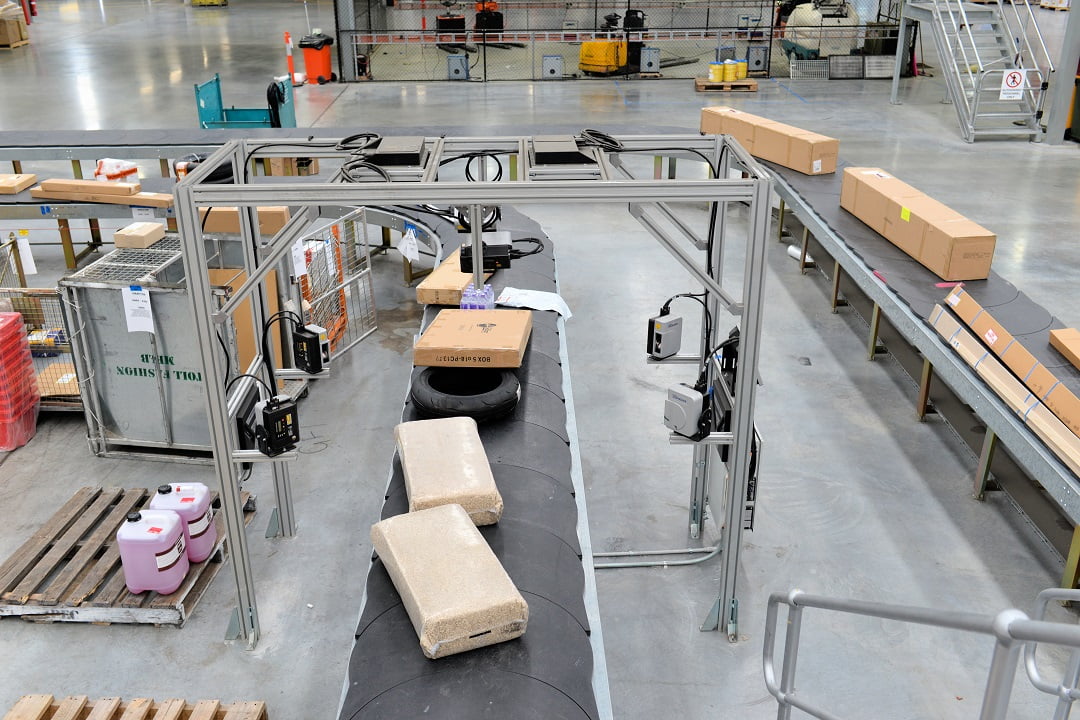
Looking at the sortation system from the viewing platform, it’s hard to piece together exactly how it works.
“There’s a North and a South sortation system and they run together – there’s a point of crossover but they are separate,” explains Noring, pointing helpfully towards something that looks like the fossilized skeleton of a huge dinosaur. “There are 11 scanning points throughout the sortation systems – these identify the package and the system informs the system which chute the package should go down.”
The way the integration works is that every item passing a scanning point is identified by a barcode, which tells the system the address, sender, the recipient, and whether the item is part of a consignment of others. It’s these scanning events, as well as scans undertaken by drivers picking up freight that are integrated with CCTV footage.
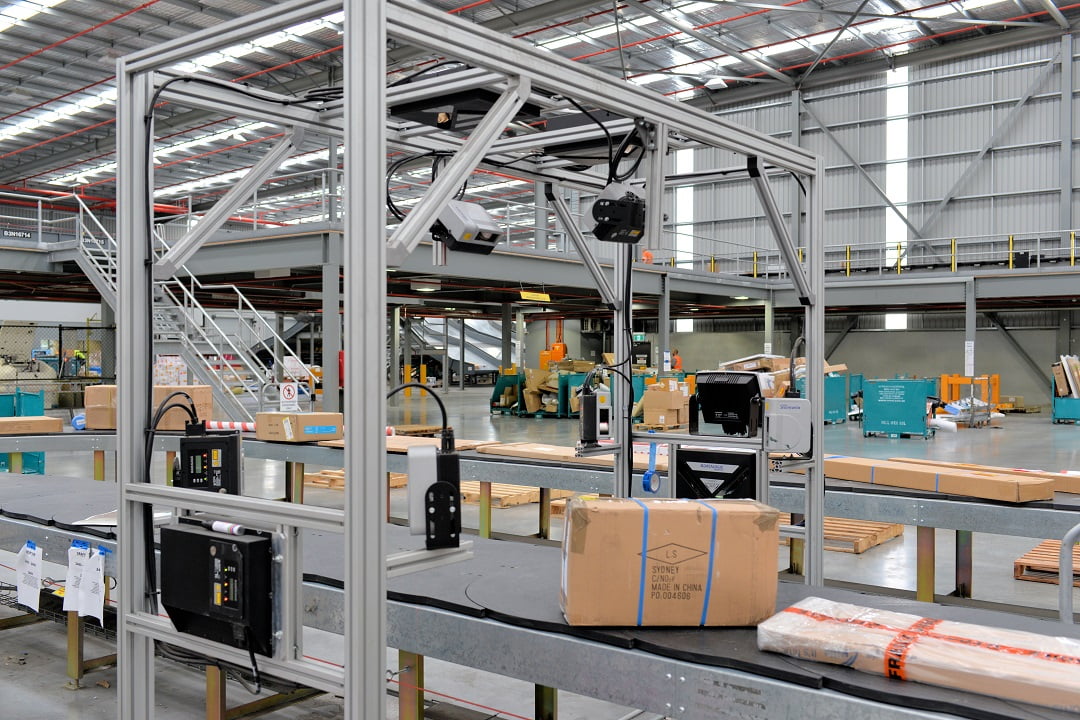
“The system is second to none in terms of being able to track freight,” says Noring. “I have a 99.9 per cent strike rate when it comes to finding freight. It’s very easy to track an item through the facility and to know exactly which truck it went onto and to know which driver was responsible for delivering it. Same with health and safety – if there’s a moment in time and a location we can find an event so quickly.”
Noring says staff and contractors are pleased with the system, too.
“We have a security and safety culture at Toll and our systems are there for the safety and security of our staff – these things go hand in hand,” he explains. “Because of the capability of our security systems, if there is an issue, staff and contractors can be eliminated from any investigations – they appreciate that.”
Touring the site
I look around on the viewing platform, trying to get a sense of the scope of the Bungaribee operation. This is not easy. The internal spaces yawn away into the distance in multiple directions like over-sized aircraft hangers. While I’m gaping, Grimshaw tells me I’m only looking at one wing of the operation. Needless to say, my camera lens is not wide enough to adequately express the context of even a single wing of Toll Bungaribee.
“It’s a quiet time of the day – we are between our busy periods,” Noring explains. “The way the site functions is that trucks come in from about 4am until 10am in the morning and then again in the afternoon. Freight is unloaded and then sorted for distribution through the sortation system and then loaded onto pickup and delivery trucks. We have 200 trucks for the Sydney region and move more than 100,000 items of freight per day through this facility.
It’s seasonal – this time of year is busier so we use more contractor drivers.”
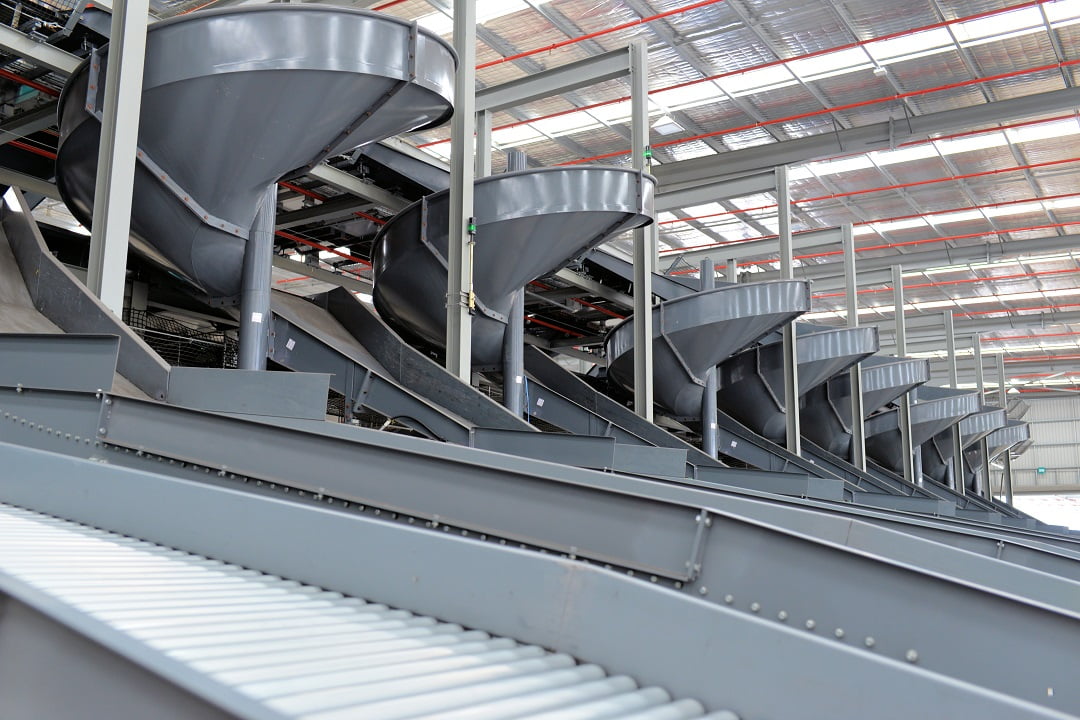
Now we head down the stairs onto the floor area. The ceilings are giddy, the sortation system winds on and on, its physical structure variously presenting the qualities of a wheat silo, coal conveyor, luggage carousel and combine harvester. In every way, this thing is huge. We walk and walk and walk.
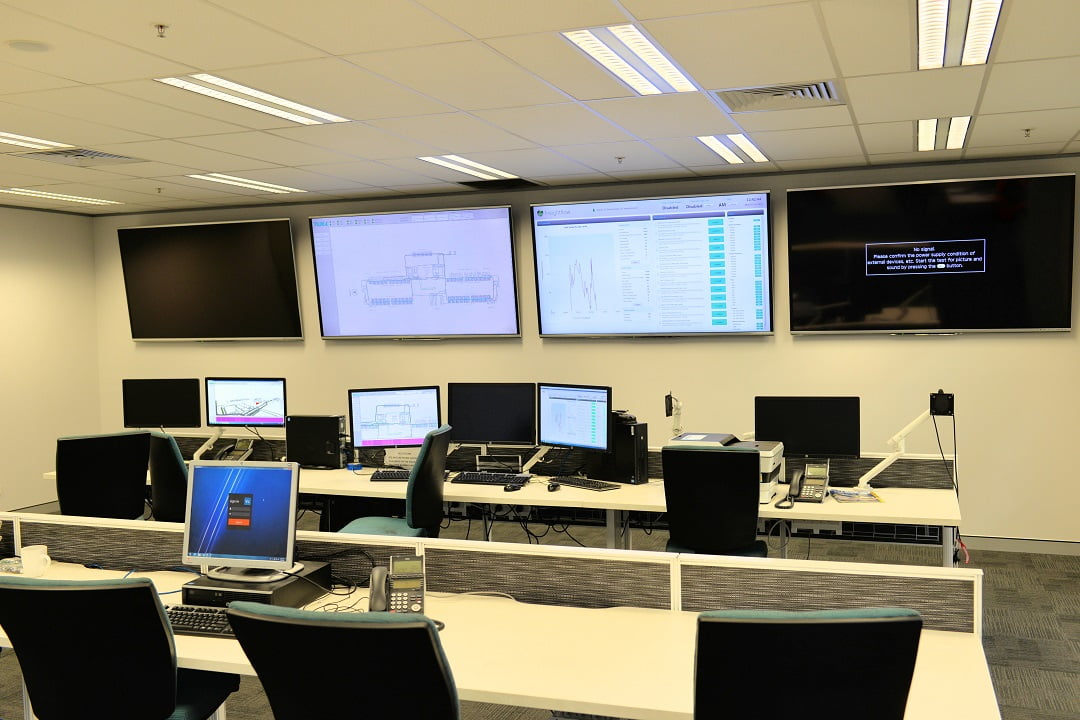
Sortation system control room
Along the way we look at the sortation system control room, which is large in its own right and has a monster video wall. You get an immediate sense how important CCTV is to the fundamental operation of this site. Next, we take a look at the network rooms, which are protected by cameras and intrusion sensors. Then it’s time to head to Toll’s National Security Monitoring Centre. Yes, it’s a car trip.
The Control Room
Toll’s Bungaribee National Security Monitoring Centre, accessed through a man-trap entrance, is long and spacious. There are multiple workstations and video walls, with some groups of camera views projected. Along with the camera views management by ExacqVision VMS, there are also screens for the management of the C-Cure solution.
“This monitoring centre (NSMC) was built in accordance with the standards and requirements of a Grade A1 Monitoring Centre and from this centre, our security officers manage, monitor, patrol over 80 Toll sites nationally,” explains Grimshaw.
“Security staff patrol sites outside of operational hours, respond to alarms and incidents, and when alerted by our systems (including our CCTV system), they undertake patrols of sites and their surrounds prior to staff seeking to gain entry or exit at opening and closing times. They also remotely open and close vehicle gates around Australia for our line haul drivers and maintain watch over them and their welfare when they visit sites outside normal operating hours.”
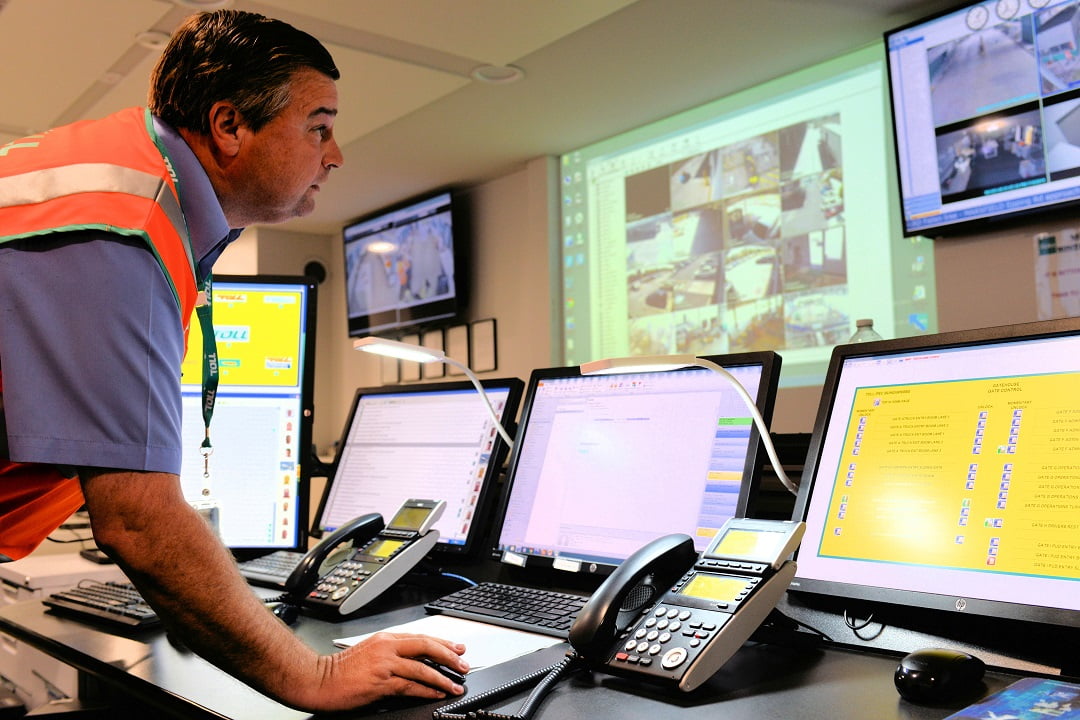
National Security Monitoring Centre
According to Grimshaw, there are 2 other sites that have been established as redundancy centres for Toll’s system monitoring requirements, with the latest site near completion at Tullamarine Airport Melbourne, to take on primary redundant/secondary responsibility when it opens.
Something that’s really telling is the root directory of the VMS. It’s not displaying any of the 450-odd cameras on the site presently, instead it’s listing the 67 sites that are monitored from this control room. Open those site names and you access their cameras. This is a serious operation.
We take a look at a screen showing the local cameras – this display is showing some key entry points. I notice the Sony cameras are doing well in this application. Gen 6 is especially solid with backlight and that’s in evidence here. Colour rendition looks good too, though it’s not as easy to discern on the projectors as it is on the screens. Perhaps the projectors have a longer range than the width of the control room and are generating a little reflectance off the wall that’s softening the images.
Taken as a whole, the National Security Monitoring Centre accurately reflects the amount of effort that went into programming, a process of weaving cameras and alarm inputs together in order to give operators the most intuitive and seamless pathways through thousands of cameras and tens of thousands of alarm and access control inputs. Using icons and VMD together was a master stroke in this regard. If you look at a camera icon and it’s green, the camera sees movement but if the icon is blue, there’s no movement.
Touches like this make the system interface easier because operators don’t have to unnecessarily engage with camera views. Something else that’s neat is the organisation of cameras into zones and areas. Taken as a whole, operators aren’t wrestling with camera numbers but interacting with a site map and drilling into views on the basis of activity.
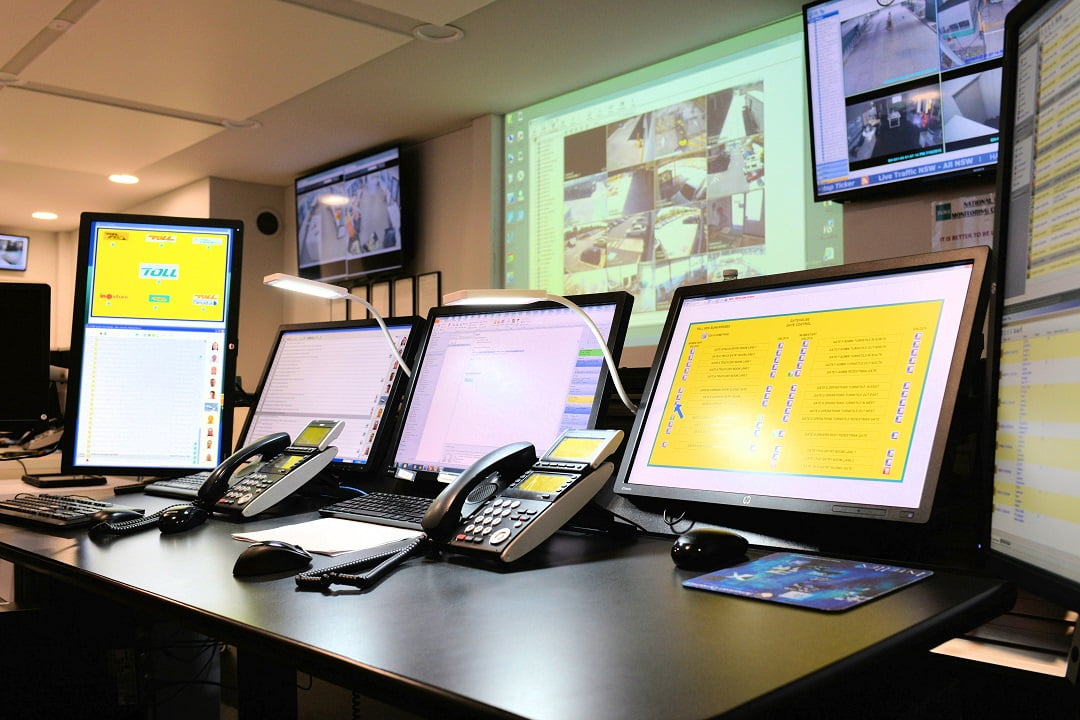
“The integration between ExaqVision and C-Cure is handled with very simple icons, events come up automatically, as do alarms,” explains Grimshaw. “The C-Cure system also controls lighting, so operators can activate quick-start lights at remote sites for arriving staff and drivers. We also have certain banks of lights that stay on all the time and these ensure that light levels are more than adequate for surveillance needs.
“Because the CCTV system can search VMD events in the past as well as generating VMD alarm events in real time, it also allows historic searches of any incident that may have occurred. We integrate thermal heat sensors and thermostats to the C-Cure as well, so we know if there’s an issue with temperature, or a network failure in a comms room – all this comes up in our event log.”

Video surveillance is a key component when it comes to monitoring and this function is layered.
“While the CCTV systems are predominantly monitored live by security officers at the NSMC, many key managers and personnel have authorised access into the system via remote connection,” Grimshaw explains. “At any given time, some of the most senior executives and managers within the business can view the systems – live or historically. This provides a multi-layered approach for observing and reviewing all aspects of a site’s operation, safety and security.”
“Was it a fiddle to get a Grade IA monitoring station installed in this facility?” I ask.
“We were originally going to install the control room underground because it ticks so many boxes of the grading requirements, but we got input from specialists, and subsequently gave our builders the required construction specifications and told them what we wanted,” Grimshaw explains. “Although we do only monitor our own sites, it’s good for insurance and it’s good that our customers know we take security seriously – it’s a positive value-add. We will apply for our full Grade 1A certification soon.”
Operationally, when it comes to monitoring cameras and getting video verification from remote sites, how does that work?
“You can see here on the C-Cure system that alarm events come up with real time video under this adjacent icon but staff can also log in and do patrols remotely,” Grimshaw explains. “But because it’s integrated with the alarm systems and there’s VMD and thermal cameras, it’s mostly event monitoring. Early detection is what we are about. If an intruder tries to get onto the site, they’ll be picked up by the VMD or the alarm system. The clear zones between our outer fences and buildings are considerable, giving us ample time to contain any intrusions.
“The C-Cure system is also integrated with our company ID photographic identification system which provides us with images of our people (card users) on the monitoring screen as they enter or exit the site. These images can be quickly reconciled against the live video feeds of the relevant entry/exit points for ID verification.
“Something else that’s worth mentioning is that we don’t mind getting false alarms,” says Grimshaw. “Alarm inputs are monitored by our own operators and they have the ability to undertake real time video tours to confirm alarm events. Because we are the ones monitoring the systems and response is remote unless there’s a genuine intrusion event, there are no costs associated with false alarm responses.”
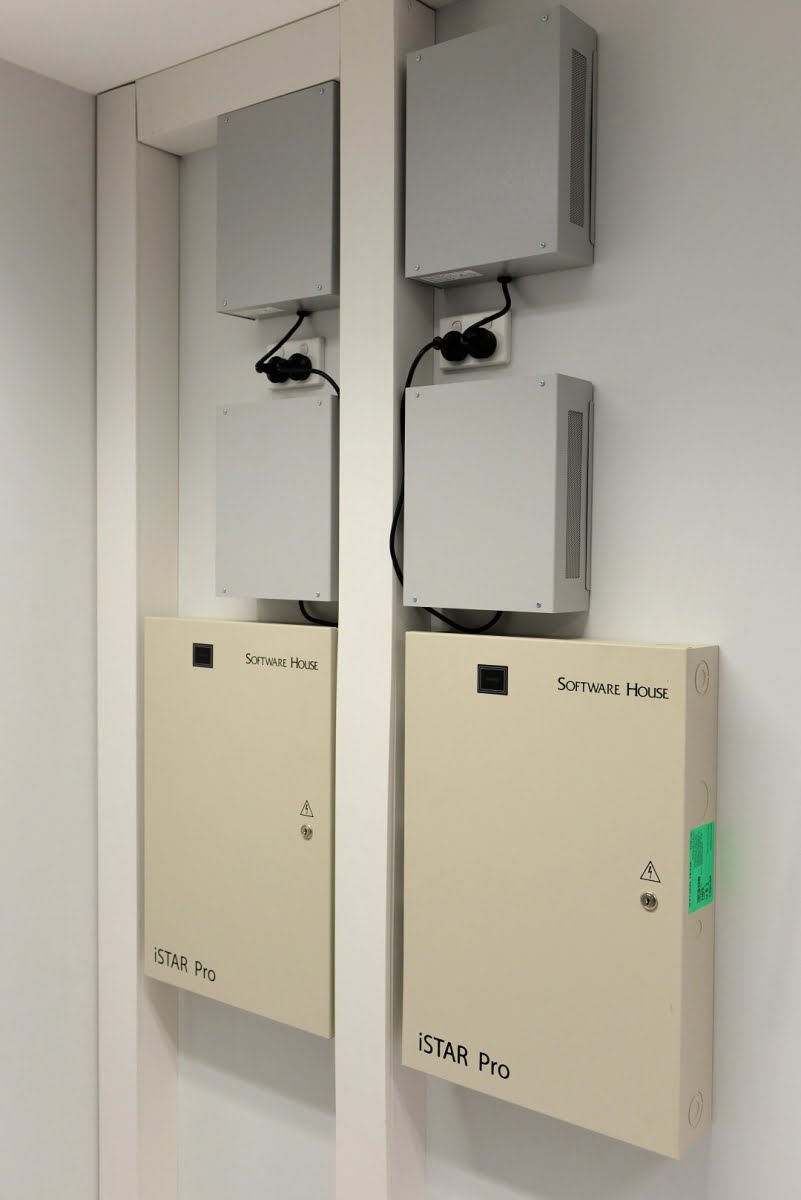
Something else that’s managed here in the National Security Monitoring Centre is the fire system. The way this works is that the CCTV system is integrated with the fire system and if there’s a fire alarm, security operators will go straight to the alarm point, assess the situation and then report their findings across the site, as well as to fire crews who might be in the process of attending an event.
“There are also have emergency alarm call points and panic buttons so staff can call for help and security operators can assess emergency calls and check the area is safe for first responders,” Grimshaw says. “Because so many people – security operators, sortation operators and managers – are viewing the system at any moment, it’s also fantastic in terms of safety.”
Conclusion
The Toll security team exhibits a strong sense of ownership of its security solution – not only for this huge site, but for the national operation. I can’t help noticing how comfortable the team is with enterprise integration of video, access control and intrusion alarms. Thinking about it later, I conclude this is because the team has been striving towards the Holy Grail of seamless national electronic security for many years. It’s telling now they’ve attained this, they are busy expanding their solution’s ability to integrate with additional subsystems.
From an operational perspective, there are many things Grimshaw likes about the Bungaribee security solution but the nature of the system has such lateral reach, it defies the bounds of a single sentence.
“Our system gives the security team a clear picture of any event that may occur, it gives management the ability to assess how operations teams are managing the work flow, it deters damage and theft onsite, and provides a substantial period of record around the site for further examination in the event of any issues,” he says. “It also ensures compliance with regulatory requirements (Aviation Transport Security Regulations 2005 – air cargo).
“While a lot of behind the scene programming was and is required, this integrated enterprise system provides a very user friendly, automated alert notification system. This is imperative, given the size of the site and the number of cameras and alarm/access control points in this system and the remote solutions monitored by our National Security Monitoring Centre.
“The cameras here are not just for security,” explains Grimshaw. “They are also used for safety, process control, monitoring of the sortation system from the separate sortation control room, and ensuring the flow of operations. The outcome is a multi-layered solution enabling all aspects of this very large site to operate more efficiently, securely and safely.” ♦
By John Adams



